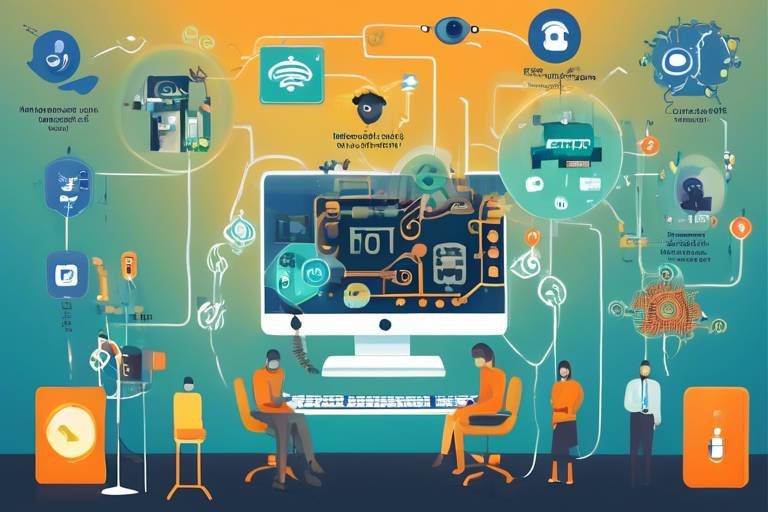Cybersecurity in the Telecommunications Industry
In today's hyper-connected world, cybersecurity has emerged as a cornerstone of the telecommunications industry. With the rapid expansion of digital communication and data sharing, protecting sensitive information is more critical than ever. Imagine your favorite smartphone app suddenly being compromised, exposing your personal data to malicious actors. Scary, right? This is the reality for many telecom companies, as they face an ever-evolving landscape of cyber threats that can disrupt operations and erode customer trust.
The telecommunications sector is particularly vulnerable due to its vast infrastructure and the sheer volume of data it processes daily. From mobile networks to internet service providers, these companies are prime targets for cybercriminals looking to exploit weaknesses. The stakes are high, as a successful breach can lead to massive financial losses, legal ramifications, and a tarnished reputation. Therefore, understanding the importance of cybersecurity in this industry is not just an option; it's a necessity.
As we delve deeper into this topic, we'll explore various aspects of cybersecurity within telecommunications, including the types of threats that loom large, regulatory compliance challenges, best practices for safeguarding data, and the role of emerging technologies in enhancing security measures. By the end of this article, you'll have a comprehensive understanding of why cybersecurity is crucial in the telecommunications sector and how companies can fortify their defenses against potential attacks.
Cyber threats come in many forms, and the telecommunications industry faces a diverse array of challenges. From malware and phishing attacks to denial-of-service (DoS) attacks, the potential impact on operations and customer trust is significant. For instance, a malware attack could compromise customer data, while a DoS attack could disrupt service, leaving customers frustrated and vulnerable.
To illustrate the severity of these threats, consider the following table that outlines some common types of cyber threats faced by telecommunications companies:
| Type of Threat | Description | Potential Impact |
|---|---|---|
| Malware | Malicious software designed to infiltrate and damage systems. | Data loss, service disruption, financial loss. |
| Phishing | Fraudulent attempts to obtain sensitive information by disguising as a trustworthy entity. | Identity theft, unauthorized access to accounts. |
| Denial-of-Service (DoS) | An attack that aims to make a service unavailable by overwhelming it with traffic. | Service outages, customer dissatisfaction. |
These threats highlight the critical need for telecommunications companies to implement robust cybersecurity measures. The potential fallout from a successful cyber attack is not just limited to immediate financial losses; it can also lead to long-term damage to a company's reputation and customer trust.
In addition to the inherent risks posed by cyber threats, telecommunications companies must also navigate a complex landscape of regulatory requirements. Regulations like the General Data Protection Regulation (GDPR) and the California Consumer Privacy Act (CCPA) impose strict guidelines on how companies handle customer data. Non-compliance can result in hefty fines and legal repercussions, making it essential for telecom operators to stay informed and compliant.
The GDPR has revolutionized the way organizations handle personal data in Europe, and its implications are far-reaching. For telecommunications companies, this means adopting stringent data protection measures and ensuring that customers' rights are respected. But what does this look like in practice? Companies must implement processes to secure data, provide transparency about data usage, and respond promptly to customer inquiries about their data.
Failing to comply with GDPR can lead to severe penalties. Imagine facing a fine of up to €20 million or 4% of your annual global turnover—whichever is higher—just for a data breach. The financial and reputational risks are enough to make any telecom executive shudder. Proactive cybersecurity measures are not just good practice; they're a necessity to avoid these dire consequences.
Another critical aspect of GDPR is the requirement for obtaining explicit consent from customers before processing their data. This mandates that telecommunications companies develop clear and concise consent management strategies. By doing so, they not only comply with regulations but also build trust with their customers, reinforcing the idea that their data is safe and respected.
Similarly, the CCPA introduces additional privacy rights for consumers in California, and telecommunications companies must adapt to these changes. This act empowers consumers with the right to know what personal information is being collected and sold, as well as the ability to opt-out of data sales. Adapting to these requirements is crucial for maintaining compliance and fostering customer loyalty.
Implementing effective cybersecurity measures is crucial for telecommunications companies. Best practices include employee training, regular audits, and incident response planning. These practices not only enhance security but also create a culture of awareness among employees, which is vital in preventing human errors that could lead to security breaches.
Training employees on cybersecurity awareness is vital. Continuous education can significantly reduce the risk of human errors. Just like a well-trained firefighter knows how to respond to a blaze, well-informed employees can identify suspicious activities and act accordingly to protect the organization.
A robust incident response plan is essential for minimizing damage during a cyber attack. This plan should outline the steps to take in the event of a breach, including communication strategies, technical responses, and recovery processes. By being prepared, telecommunications companies can respond swiftly and effectively, mitigating potential damage.
Innovative technologies play a significant role in enhancing cybersecurity. Advancements such as artificial intelligence (AI), machine learning, and blockchain are transforming the landscape of cybersecurity in the telecommunications industry. These technologies can improve threat detection, automate responses, and enhance data integrity.
Artificial intelligence can enhance threat detection and response times. By analyzing vast amounts of data, AI can identify patterns and anomalies that may indicate a breach, allowing companies to act quickly. It's like having a digital watchdog that never sleeps, constantly on the lookout for potential threats.
Blockchain technology offers a decentralized approach to data security. By leveraging blockchain, telecommunications companies can enhance data integrity and protect against unauthorized access. This technology creates a transparent and tamper-proof record of transactions, making it incredibly difficult for cybercriminals to manipulate data.
As the telecommunications landscape evolves, so do the cybersecurity challenges. The rise of 5G and the Internet of Things (IoT) present unique security vulnerabilities. Companies must adapt their cybersecurity strategies to address these emerging threats while continuing to protect sensitive data.
The rollout of 5G networks introduces new security vulnerabilities. With faster speeds and greater connectivity, the potential for cyber attacks increases. Telecommunications companies must implement robust security measures to protect these networks from threats that could disrupt services and compromise customer data.
The proliferation of IoT devices presents significant security risks. Each connected device can serve as a potential entry point for cybercriminals. Therefore, securing IoT in telecommunications is crucial. Companies must develop strategies to mitigate these risks, ensuring that all devices are adequately protected.
In conclusion, addressing cybersecurity in the telecommunications industry is paramount for safeguarding sensitive information and maintaining customer trust. As we've explored, the landscape is fraught with challenges, but by implementing best practices and embracing emerging technologies, companies can fortify their defenses against cyber threats. Ongoing vigilance and innovation in cybersecurity practices are essential to navigate this complex environment successfully.
- What are the main cyber threats facing telecommunications companies? Common threats include malware, phishing attacks, and denial-of-service attacks.
- How does GDPR affect telecommunications companies? GDPR imposes strict guidelines on data handling, requiring companies to obtain explicit consent from customers and implement robust data protection measures.
- What best practices can telecommunications companies adopt for cybersecurity? Companies should focus on employee training, regular audits, and developing a solid incident response plan.
- How can emerging technologies enhance cybersecurity? Technologies like AI and blockchain can improve threat detection, automate responses, and enhance data integrity.

Understanding Cyber Threats
In today's hyper-connected world, the telecommunications industry stands as a critical backbone of global communication. However, this vital sector faces a myriad of cyber threats that can disrupt operations and erode customer trust. From malware and phishing attacks to denial-of-service (DoS) attacks, the landscape of cyber threats is ever-evolving and increasingly sophisticated. Understanding these threats is crucial for telecommunications companies to develop effective cybersecurity strategies.
One of the most pervasive threats is malware, which refers to malicious software designed to infiltrate and damage systems. This can range from viruses that corrupt data to ransomware that locks users out of their systems until a ransom is paid. The impact of malware can be devastating, leading to significant operational downtime and financial loss.
Phishing attacks are another common threat, where cybercriminals impersonate legitimate entities to trick individuals into revealing sensitive information, such as passwords or credit card numbers. These attacks often come in the form of deceptive emails or messages that look remarkably authentic. For telecommunications companies, falling victim to phishing can compromise customer data and lead to catastrophic breaches of trust.
Moreover, denial-of-service (DoS) attacks aim to overwhelm a network or service with excessive traffic, causing it to become unavailable to legitimate users. Such attacks can paralyze telecommunications operations, affecting not just the company but also millions of customers relying on their services. The consequences can be far-reaching, resulting in loss of revenue and damage to brand reputation.
To illustrate the impact of these cyber threats, consider the following table:
| Type of Cyber Threat | Description | Potential Impact |
|---|---|---|
| Malware | Malicious software that damages or disrupts systems. | Operational downtime, financial loss. |
| Phishing | Fraudulent attempts to obtain sensitive information. | Data breaches, loss of customer trust. |
| Denial-of-Service | Overloading a service to make it unavailable. | Service outages, loss of revenue. |
As we navigate this complex landscape, it’s essential for telecommunications companies to adopt a proactive approach to cybersecurity. This involves not only implementing robust security measures but also fostering a culture of awareness among employees. After all, the human element is often the weakest link in the cybersecurity chain. By educating staff about the signs of cyber threats, companies can significantly reduce the risk of falling victim to these attacks.
In conclusion, understanding the various types of cyber threats is the first step in building a resilient telecommunications infrastructure. By recognizing the potential impacts of malware, phishing, and DoS attacks, companies can better prepare themselves to defend against these challenges. It’s not just about technology; it’s about creating a culture of security that prioritizes the protection of sensitive data and maintains customer trust.
- What are the most common cyber threats in telecommunications? The most common threats include malware, phishing attacks, and denial-of-service attacks.
- How can telecommunications companies protect themselves from cyber threats? Companies can implement robust cybersecurity measures, conduct regular training for employees, and develop incident response plans.
- Why is employee training important in cybersecurity? Continuous education helps employees recognize potential threats and reduces the likelihood of human error leading to security breaches.

Regulatory Compliance
In the fast-paced world of telecommunications, is a critical aspect that companies must navigate carefully. With the increasing amount of sensitive data being processed, regulations such as the General Data Protection Regulation (GDPR) and the California Consumer Privacy Act (CCPA) have been established to ensure that consumer data is handled with the utmost care. These regulations not only aim to protect consumer privacy but also impose significant responsibilities on telecommunications providers to secure data against breaches and misuse.
Compliance with these regulations can feel like navigating a maze, but understanding their implications is essential for maintaining customer trust and avoiding hefty fines. For instance, the GDPR applies to any company that processes the personal data of EU citizens, regardless of where the company is based. This means that even telecommunications companies outside the EU must comply if they handle such data. Similarly, the CCPA focuses on enhancing privacy rights for California residents, giving them more control over their personal information.
To break it down further, let’s take a closer look at how these regulations impact telecommunications companies:
| Regulation | Implications for Telecom Companies |
|---|---|
| GDPR | Requires explicit consent for data processing, imposes strict data protection measures, and mandates reporting of data breaches within 72 hours. |
| CCPA | Gives consumers the right to know what personal data is collected, the right to delete their data, and the right to opt-out of data selling. |
By understanding these regulations, telecommunications companies can implement necessary changes to their operations. For example, they need to establish robust data protection policies, conduct regular audits, and ensure that their staff is trained on compliance matters. Failure to comply can result in severe penalties, including fines that can reach millions of dollars, not to mention the potential damage to a company's reputation.
Moreover, obtaining customer consent is a significant aspect under GDPR. It’s not just about asking for permission; it’s about ensuring that customers are fully informed about how their data will be used. This transparency builds trust and fosters a positive relationship between telecom providers and their customers. Companies must also have processes in place to manage this consent effectively, allowing customers to easily withdraw their consent if they choose to do so.
In conclusion, navigating regulatory compliance in the telecommunications industry is not just a legal obligation; it is a fundamental aspect of building and maintaining customer relationships. As the landscape evolves, companies must remain vigilant and proactive in adapting to these regulations to protect both their customers and their business.
- What is GDPR and how does it affect telecommunications companies? GDPR is a regulation that protects the personal data of EU citizens. Telecommunications companies must comply by ensuring data protection and obtaining explicit consent for data processing.
- What are the penalties for non-compliance with CCPA? Non-compliance with CCPA can lead to fines of up to $7,500 per violation, which can add up quickly depending on the number of affected consumers.
- How can telecommunications companies ensure compliance with these regulations? Companies can ensure compliance by implementing strong data protection policies, conducting regular audits, and training employees on privacy and data security best practices.

Impact of GDPR
The General Data Protection Regulation (GDPR) has fundamentally transformed how telecommunications companies handle personal data. Enforced since May 2018, GDPR sets stringent rules that require organizations to prioritize data protection and privacy. This regulation is not just a guideline; it’s a legal framework that demands compliance, and failure to adhere can lead to hefty fines. For telcos, this means that every piece of customer data must be processed with the utmost care and transparency.
One of the most significant impacts of GDPR is the requirement for explicit consent from customers before their data can be collected or processed. This means that telecommunications companies must ensure that their data collection practices are not only transparent but also comprehensible to the average consumer. Imagine trying to decipher a complex legal document; that’s how many customers feel when faced with lengthy privacy policies. Therefore, companies need to simplify these documents and ensure customers genuinely understand what they are consenting to.
Additionally, GDPR mandates that customers have the right to access their data, request corrections, and even demand deletion. This introduces a new level of accountability for telecommunications providers. They must implement robust systems to handle such requests efficiently. To illustrate the potential challenges, consider the following:
| Challenge | Implication |
|---|---|
| Data Access Requests | Companies must develop processes to respond to customer requests promptly, which can be resource-intensive. |
| Data Breach Notification | In case of a breach, companies have 72 hours to notify authorities and affected individuals, increasing pressure on incident response teams. |
| Data Minimization | Only necessary data should be collected, complicating traditional data collection practices. |
Moreover, the regulation emphasizes the principle of data minimization, meaning that telecommunications companies should only collect data that is necessary for their operations. This can be a double-edged sword; while it enhances privacy, it may also limit the ability of companies to analyze data for improving services or creating personalized offers. Balancing these needs requires careful strategy and planning.
In light of these challenges, telecommunications companies must invest in technology and training to ensure compliance. This includes implementing advanced data management systems and conducting regular audits to assess compliance levels. Furthermore, companies need to foster a culture of data protection awareness among employees, as human error can often lead to breaches. By conducting ongoing training programs and workshops, companies can mitigate risks associated with non-compliance.
In summary, the impact of GDPR on the telecommunications industry is profound. It compels companies to rethink their data handling practices, ensuring they are not only compliant but also capable of maintaining customer trust. As consumer awareness of data privacy grows, companies that prioritize compliance and transparency will likely gain a competitive edge in the market.
- What is GDPR? GDPR is a regulation that protects the privacy and personal data of individuals in the European Union.
- How does GDPR affect telecommunications companies? It requires them to obtain explicit consent for data processing and to implement robust data protection measures.
- What are the penalties for non-compliance? Companies can face fines of up to 4% of their annual global turnover or €20 million, whichever is greater.

Data Breach Consequences
When it comes to the telecommunications industry, the implications of a data breach are nothing short of catastrophic. Imagine waking up to find that sensitive customer information has been compromised. The fallout from such an event can be devastating, not only in terms of immediate financial losses but also in the long-term damage to a company's reputation. In fact, studies have shown that companies can lose up to 20% of their customers following a significant data breach.
Furthermore, the financial penalties imposed under regulations like the General Data Protection Regulation (GDPR) can be staggering. Companies that fail to protect customer data may face fines that reach up to €20 million or 4% of their annual global turnover, whichever is higher. This is a wake-up call for telecommunications companies to prioritize their cybersecurity measures. The table below outlines some of the potential financial impacts of a data breach:
| Impact Category | Potential Cost |
|---|---|
| Regulatory Fines | Up to €20 million or 4% of annual turnover |
| Legal Fees | Varies, often exceeding €1 million |
| Customer Compensation | Can exceed €2 million |
| Reputational Damage | Loss of up to 20% of customers |
In addition to financial repercussions, the reputational damage from a data breach can be particularly hard to mend. Customers expect their personal information to be safeguarded, and once trust is broken, it can take years to rebuild. Companies may find themselves facing negative media coverage, which can further exacerbate the situation. It's like trying to put toothpaste back in the tube; once it's out, it's nearly impossible to contain.
Moreover, the operational impact of a data breach cannot be overlooked. Companies may need to divert resources to address the breach, conduct investigations, and enhance their security protocols. This diversion can lead to significant downtime and lost productivity, which can be a double whammy for the business. In essence, the consequences of a data breach extend far beyond immediate financial loss; they ripple through every facet of the organization.
To mitigate these risks, telecommunications companies must adopt a proactive stance on cybersecurity. This includes investing in robust security measures, conducting regular audits, and fostering a culture of cybersecurity awareness among employees. After all, in the digital age, your first line of defense is often your workforce. By prioritizing cybersecurity, companies can protect not only their bottom line but also their most valuable asset: customer trust.
- What should I do if my data has been breached?
Contact the company immediately, monitor your accounts for suspicious activity, and consider placing a fraud alert on your credit report. - How can companies prevent data breaches?
Implement strong security measures, conduct regular training for employees, and stay updated on the latest cybersecurity trends. - What are the legal consequences of a data breach?
Companies can face substantial fines, legal action from affected customers, and significant reputational damage.

Customer Consent Requirements
In today's digital landscape, where data is the new gold, obtaining explicit customer consent for data processing is not just a legal obligation but a fundamental aspect of building trust. Under the General Data Protection Regulation (GDPR), telecommunications companies are mandated to secure clear and affirmative consent from their customers before collecting or processing their personal data. This requirement is crucial because it empowers consumers by giving them control over their own information, ensuring that they are fully aware of how their data is being used.
To navigate this complex requirement effectively, telecommunications companies must implement robust consent management systems. These systems should not only facilitate the collection of consent but also maintain detailed records of when and how consent was obtained. Moreover, it’s essential to provide customers with easy access to their consent preferences, allowing them to withdraw consent at any time. This is where transparency plays a pivotal role; customers should feel confident that their privacy is respected and that they have the power to manage their data.
One effective strategy for managing customer consent is to utilize layered privacy notices. This approach involves providing a brief summary of data processing activities upfront, with an option for customers to access more detailed information if they wish. By presenting information in a clear and concise manner, companies can enhance customer understanding and facilitate informed decision-making. Additionally, it’s important to ensure that consent requests are not bundled with other agreements, as this can lead to confusion and may not meet GDPR standards.
To illustrate the importance of customer consent, consider the following table that outlines the key components of a successful consent management strategy:
| Component | Description |
|---|---|
| Clarity | Ensure that consent requests are straightforward and easy to understand. |
| Granularity | Allow customers to provide consent for specific data processing activities. |
| Accessibility | Provide customers with easy access to their consent preferences. |
| Revocability | Enable customers to withdraw their consent at any time without hassle. |
Ultimately, the focus should be on fostering a culture of privacy within the organization. This involves training employees on the importance of customer consent and ensuring that all departments understand their role in protecting customer data. By prioritizing customer consent and transparency, telecommunications companies can not only comply with regulations like GDPR but also enhance their reputation and build lasting relationships with their customers.
- What is customer consent in telecommunications?
Customer consent refers to the explicit permission obtained from customers before their personal data can be collected or processed by telecommunications companies. - Why is customer consent important?
It is essential for compliance with regulations like GDPR and CCPA and helps to build trust between the company and its customers. - How can telecommunications companies manage customer consent effectively?
By implementing clear consent management systems, providing layered privacy notices, and ensuring that consent requests are straightforward and easily accessible. - Can customers withdraw their consent?
Yes, customers have the right to withdraw their consent at any time, and companies must facilitate this process.

Impact of CCPA
The California Consumer Privacy Act (CCPA) is a significant piece of legislation that reshapes how businesses, particularly in the telecommunications sector, handle consumer data. Enacted to enhance privacy rights and consumer protection, the CCPA grants California residents greater control over their personal information. For telecommunications companies, complying with CCPA is not just a legal obligation; it’s a crucial step toward building and maintaining trust with their customers.
One of the most critical aspects of CCPA is its emphasis on transparency. Telecommunications companies must clearly disclose what personal data they collect, how it is used, and with whom it is shared. This transparency is vital because, in an age where data breaches are rampant, consumers are more concerned than ever about how their information is handled. By adhering to these regulations, companies can foster a sense of trust, which is essential for customer loyalty.
Moreover, CCPA provides consumers with the right to access their personal data, request deletion of their information, and opt-out of the sale of their data. This empowerment of consumers means that telecommunications companies need to implement robust systems to manage these requests efficiently. Failure to comply can result in hefty fines and damage to the company's reputation. The following table outlines the key consumer rights under CCPA:
| Consumer Right | Description |
|---|---|
| Right to Know | Consumers can request details about the personal information collected about them. |
| Right to Delete | Consumers can request the deletion of their personal data held by businesses. |
| Right to Opt-Out | Consumers can opt-out of the sale of their personal information to third parties. |
To effectively comply with CCPA, telecommunications companies must invest in technology and processes that facilitate data management and consumer rights requests. This includes developing user-friendly interfaces for consumers to exercise their rights and ensuring that all employees are trained on these new protocols. Additionally, regular audits and assessments of data practices are essential to ensure ongoing compliance and to identify areas for improvement.
In conclusion, the impact of CCPA on telecommunications companies is profound. Not only does it require them to rethink their data handling practices, but it also presents an opportunity to enhance customer relationships through transparency and respect for consumer privacy. By prioritizing compliance with CCPA, telecommunications companies can not only avoid penalties but also position themselves as leaders in data protection and consumer trust.
- What is CCPA? The California Consumer Privacy Act is a law that enhances privacy rights and consumer protection for residents of California.
- How does CCPA affect telecommunications companies? It requires them to be transparent about data collection, provide consumers with rights regarding their data, and implement systems for compliance.
- What are the penalties for non-compliance with CCPA? Companies can face significant fines and reputational damage if they fail to comply with the regulations set forth by CCPA.

Best Practices for Cybersecurity
In the fast-paced world of telecommunications, implementing effective cybersecurity measures is not just a luxury; it's a necessity. With the increasing sophistication of cyber threats, companies must adopt a proactive approach to safeguard their networks and sensitive data. One of the most crucial aspects of this strategy is employee training. Employees are often the first line of defense against cyber attacks, and equipping them with the right knowledge can significantly reduce the risk of human error leading to security breaches. Continuous education programs that focus on recognizing phishing attempts, understanding malware, and practicing safe browsing habits can empower employees to act as vigilant guardians of company data.
Another essential practice is conducting regular security audits. These audits are not just about compliance; they are about understanding your vulnerabilities and addressing them before they can be exploited. By systematically evaluating your systems and protocols, you can identify weak spots and implement necessary improvements. Regular audits also help in keeping up with the ever-evolving landscape of cyber threats, ensuring that your defenses are always one step ahead.
Moreover, having a well-defined incident response plan is vital. This plan should outline the steps to take in the event of a cyber attack, including communication protocols, roles and responsibilities, and recovery strategies. A swift and organized response can mean the difference between a minor inconvenience and a catastrophic breach. Companies should conduct regular drills to ensure that all employees are familiar with the plan and can act effectively under pressure.
To further enhance security, telecommunications companies should consider implementing a multi-layered security approach. This involves utilizing various security measures, such as firewalls, intrusion detection systems, and encryption, to create multiple barriers against potential threats. Each layer serves as a checkpoint, making it more difficult for cybercriminals to gain access to sensitive information. For example, even if a hacker manages to bypass the first layer, they will still face additional defenses that can thwart their efforts.
One of the most effective ways to maintain cybersecurity is by fostering a culture of security within the organization. This means that every employee, regardless of their role, should understand the importance of cybersecurity and how their actions can impact the company's overall security posture. Regular workshops, informative newsletters, and open discussions about security practices can help instill this mindset across all levels of the organization.
Lastly, staying updated with the latest trends and technologies in cybersecurity is crucial. The cyber landscape is constantly changing, and what worked yesterday may not be effective today. By keeping abreast of new threats and advancements in security technologies, telecommunications companies can adapt their strategies accordingly. For instance, embracing innovative solutions like artificial intelligence for threat detection and response can significantly bolster a company’s defenses.
- What are the most common cyber threats in telecommunications?
Common threats include malware, phishing attacks, and denial-of-service attacks that can disrupt services and compromise sensitive data. - How often should companies conduct security audits?
It is recommended to perform security audits at least annually, but quarterly audits can provide a more proactive approach to identifying vulnerabilities. - What should be included in an incident response plan?
An effective incident response plan should include communication protocols, roles and responsibilities, recovery strategies, and regular training drills. - How can employee training improve cybersecurity?
Training helps employees recognize potential threats and understand safe practices, significantly reducing the likelihood of human error leading to breaches.

Employee Training Programs
In the ever-evolving landscape of cybersecurity, one of the most critical defenses a telecommunications company can implement is a robust employee training program. Why is this so important? Well, think of employees as the first line of defense against cyber threats. Just as a well-trained soldier is essential in a battle, educated employees are vital in the fight against cybercrime. By equipping them with the knowledge and skills necessary to identify and respond to potential threats, companies can significantly reduce the risk of breaches caused by human error.
Training programs should not be one-off events; rather, they should be ongoing initiatives that adapt to the latest threats and technologies. For instance, regular workshops and seminars can keep employees informed about new phishing tactics or malware trends. Moreover, incorporating real-life scenarios into training can enhance engagement and retention of knowledge. When employees can visualize the threats they might face, they are more likely to remember the protocols they need to follow.
Here are some essential components that should be included in any effective employee training program:
- Awareness of Cyber Threats: Employees should be educated on the various types of cyber threats they may encounter, such as phishing emails, social engineering attacks, and ransomware.
- Best Practices for Data Protection: Training should cover secure password practices, data encryption, and safe internet browsing habits.
- Incident Reporting Procedures: Employees must know how to report suspicious activities or potential breaches quickly and effectively.
Additionally, it’s essential to create a culture of security within the organization. When cybersecurity becomes a shared responsibility, employees are more likely to take ownership of their actions. This culture can be fostered through regular communications from leadership about the importance of cybersecurity and by recognizing employees who demonstrate good security practices.
Finally, measuring the effectiveness of training programs is crucial. Companies can conduct assessments and simulations to evaluate employees' understanding and readiness to respond to cyber threats. This feedback loop not only helps in refining the training content but also reinforces the importance of cybersecurity among staff.
In conclusion, investing in comprehensive employee training programs is not just a checkbox on a compliance list; it is a strategic move that can significantly bolster a telecommunications company's defenses against cyber threats. By empowering employees with the right knowledge and tools, organizations can create a proactive approach to cybersecurity that ultimately protects sensitive data and maintains customer trust.
1. Why is employee training important for cybersecurity?
Employee training is vital because human error is often the weakest link in cybersecurity. Educated employees can recognize threats and respond appropriately, reducing the risk of breaches.
2. How often should employee training be conducted?
Training should be ongoing, with regular updates to reflect new threats and technologies. Quarterly workshops or monthly updates can keep employees informed and engaged.
3. What are some effective training methods?
Effective methods include interactive workshops, real-life scenario simulations, and regular assessments to gauge understanding and preparedness.
4. How can companies foster a culture of cybersecurity?
Companies can promote a culture of cybersecurity by encouraging open communication about threats, recognizing employees who follow best practices, and having leadership emphasize its importance.

Incident Response Planning
When it comes to cybersecurity, having a robust incident response plan is like having a safety net beneath a tightrope walker. You might not need it every day, but when a crisis strikes, you'll be glad it's there. An effective incident response plan not only minimizes the damage during a cyber attack but also helps organizations recover swiftly and efficiently. In the telecommunications industry, where sensitive data and customer trust are at stake, this plan becomes even more critical.
So, what exactly does an incident response plan entail? At its core, it should outline the steps to be taken when a security breach occurs. This includes identifying the breach, containing the threat, eradicating the cause, and recovering from the incident. But that’s just the surface. A comprehensive plan goes deeper, involving various stakeholders, communication strategies, and continuous improvement mechanisms.
Here are some key components of an effective incident response strategy:
- Preparation: This involves training your team, establishing communication channels, and setting up necessary tools and technologies.
- Identification: Quickly recognizing a security incident is crucial. This may involve monitoring systems for unusual activity and analyzing alerts.
- Containment: Once a breach is identified, immediate steps must be taken to contain it. This could mean isolating affected systems to prevent further damage.
- Eradication: After containment, it's essential to remove the threat from the environment. This could involve deleting malware, closing vulnerabilities, and ensuring that the threat is completely eliminated.
- Recovery: Once the threat is eradicated, systems must be restored to normal operations. This includes restoring data from backups and ensuring that all systems are secure before going back online.
- Lessons Learned: After an incident, it’s crucial to analyze what happened, how it was handled, and what can be improved. This step ensures that the organization learns from each incident and strengthens its defenses against future threats.
Furthermore, regular testing and updating of the incident response plan are vital. Cyber threats evolve rapidly, and what worked yesterday may not be effective today. Conducting simulations and tabletop exercises can help your team practice their response and refine the plan based on real-world scenarios.
In addition, communication plays a significant role in incident response. Keeping stakeholders informed, including employees, customers, and regulatory bodies, is essential for maintaining trust and transparency. A well-prepared communication strategy can help mitigate reputational damage during a crisis.
To sum it up, an effective incident response plan is not just a document—it's a living strategy that requires ongoing attention and adaptation. By prioritizing incident response planning, telecommunications companies can not only protect their networks but also enhance their overall resilience against cyber threats.
- What is an incident response plan? An incident response plan is a documented strategy outlining the processes to follow when a cybersecurity incident occurs.
- Why is incident response planning important? It helps organizations minimize damage, recover quickly, and learn from incidents to improve future responses.
- How often should an incident response plan be updated? Regularly, at least annually, or after any significant incident or change in the threat landscape.
- Who should be involved in incident response planning? A cross-functional team including IT, legal, communications, and management should collaborate to create and maintain the plan.

Emerging Technologies
In today's fast-paced digital world, the telecommunications industry is constantly evolving, and with it comes the need for enhanced cybersecurity measures. Emerging technologies are not just buzzwords; they represent the future of how we can protect sensitive data and ensure secure communications. As cyber threats become more sophisticated, so too must our defenses. This section delves into some of the most promising technologies that are reshaping cybersecurity in telecommunications, including artificial intelligence (AI), machine learning, and blockchain. Each of these technologies offers unique advantages that can significantly bolster security protocols.
One of the most exciting advancements in the realm of cybersecurity is the integration of artificial intelligence. AI systems are designed to analyze vast amounts of data at lightning speed, enabling them to detect anomalies that traditional systems might miss. For instance, AI can monitor network traffic in real-time, identifying unusual patterns that could indicate a potential cyber attack. By employing machine learning algorithms, these AI systems can continuously improve their threat detection capabilities based on new data, making them increasingly effective over time. This proactive approach not only enhances security but also reduces response times, allowing telecommunications companies to act swiftly in the face of threats.
Another groundbreaking technology is blockchain, which offers a decentralized method of securing data. Unlike traditional databases that are stored in a single location, blockchain distributes data across multiple nodes, making it nearly impossible for hackers to alter or access sensitive information without detection. This decentralized approach not only enhances data integrity but also provides a transparent record of transactions and changes, which is crucial for regulatory compliance. Telecommunications companies can leverage blockchain to secure customer data, ensuring that it remains confidential and protected against unauthorized access.
To illustrate the potential impact of these technologies, consider the following table that summarizes their key features and benefits:
| Technology | Key Features | Benefits |
|---|---|---|
| Artificial Intelligence | Real-time monitoring, anomaly detection, adaptive learning | Faster threat detection, reduced response time, continuous improvement |
| Machine Learning | Data analysis, predictive analytics, pattern recognition | Identifies potential threats before they occur, enhances decision-making |
| Blockchain | Decentralized data storage, immutability, transparency | Increased data integrity, improved security against unauthorized access |
As we look toward the future, it's clear that these emerging technologies will play a pivotal role in shaping the cybersecurity landscape within the telecommunications sector. With the rise of 5G networks and the Internet of Things (IoT), the need for robust security measures will only intensify. Telecommunications companies must stay ahead of the curve by embracing these innovations and integrating them into their cybersecurity strategies. By doing so, they can not only protect their operations but also maintain the trust of their customers in an increasingly digital world.
- What role does AI play in enhancing cybersecurity?
AI helps in monitoring networks, detecting anomalies, and improving threat response times through continuous learning. - How does blockchain improve data security?
Blockchain offers a decentralized storage solution that enhances data integrity and protects against unauthorized access. - Why is employee training important in cybersecurity?
Continuous education helps prevent human errors that can lead to security breaches, making employees a crucial line of defense. - What are the implications of 5G for cybersecurity?
5G introduces new security vulnerabilities that require updated strategies to protect against potential cyber threats.

AI in Cybersecurity
Artificial Intelligence (AI) is revolutionizing the field of cybersecurity, especially within the telecommunications industry. Imagine having a digital guardian that never sleeps, constantly monitoring networks for suspicious activities. That's the power of AI! By leveraging advanced algorithms and machine learning techniques, AI can analyze vast amounts of data in real-time, identifying potential threats much faster than any human could. This capability is crucial in a sector where every second counts and where the stakes are incredibly high.
One of the key advantages of AI in cybersecurity is its ability to learn and adapt. Traditional security measures often rely on predefined rules that can be easily bypassed by sophisticated cybercriminals. In contrast, AI systems can evolve by learning from past incidents, thereby improving their threat detection capabilities over time. For example, if a particular type of malware is detected, the AI can analyze its behavior and develop a strategy to identify similar threats in the future. This proactive approach is akin to having a seasoned detective who learns from every case they solve, becoming more adept at spotting patterns and anomalies.
Moreover, AI can automate routine tasks that would typically require human intervention. This not only frees up valuable resources but also minimizes the chances of human error, which is one of the leading causes of security breaches. For instance, AI can manage log analysis, monitor network traffic, and even respond to incidents, allowing cybersecurity teams to focus on more complex challenges. This automation is similar to how modern cars come equipped with advanced driving assistance systems, helping drivers navigate safely while reducing the likelihood of accidents.
However, the implementation of AI in cybersecurity is not without its challenges. Organizations must ensure that their AI systems are trained on diverse datasets to avoid biases that could lead to false positives or negatives. Additionally, as AI becomes more prevalent, cybercriminals are also leveraging AI technologies to develop more sophisticated attacks. This creates an ongoing arms race between defenders and attackers, emphasizing the need for continuous innovation and adaptation in security measures.
To sum it up, AI is transforming the way cybersecurity is approached in the telecommunications industry. Its ability to learn, adapt, and automate processes makes it an invaluable tool in the fight against cyber threats. As we look to the future, the integration of AI into cybersecurity strategies will be essential for safeguarding sensitive data and maintaining the trust of customers in an increasingly digital world.
- How does AI improve threat detection in cybersecurity? AI enhances threat detection by analyzing large datasets in real-time and identifying patterns that may indicate potential security threats.
- Can AI systems be hacked? Yes, while AI systems improve cybersecurity, they can also be targeted by cybercriminals. It's essential to continuously update and secure AI systems.
- What are the limitations of AI in cybersecurity? AI systems can suffer from biases if not trained on diverse datasets, and they may also struggle with novel threats that they have not encountered before.
- Is AI a replacement for human cybersecurity professionals? No, AI is a tool that assists cybersecurity professionals. Human oversight is still crucial for complex decision-making and strategy formulation.

Blockchain for Data Security
In the ever-evolving landscape of cybersecurity, blockchain technology has emerged as a beacon of hope for enhancing data security in the telecommunications industry. Imagine a world where data integrity is guaranteed, and unauthorized access becomes a thing of the past. This is the promise that blockchain holds. By leveraging its decentralized nature, telecommunications companies can create a more robust security framework that not only protects sensitive information but also fosters trust among customers.
At its core, blockchain is a distributed ledger technology that records transactions across multiple computers in such a way that the registered transactions cannot be altered retroactively. This characteristic makes it incredibly difficult for hackers to manipulate data. When applied to telecommunications, blockchain can address several key challenges:
- Data Integrity: Each transaction is linked to the previous one, creating a chain that is transparent and immutable. This ensures that any changes to data are easily traceable.
- Decentralization: Since the data is stored across a network of computers rather than a single server, it reduces the risk of a single point of failure.
- Enhanced Authentication: Blockchain can streamline the authentication process, making it more secure and efficient by using cryptographic techniques.
Furthermore, blockchain can facilitate secure communication between devices in the Internet of Things (IoT) ecosystem. As telecommunications companies increasingly integrate IoT devices into their networks, the need for secure data exchanges becomes critical. By utilizing blockchain, companies can ensure that data transmitted between devices is encrypted and tamper-proof, significantly mitigating the risk of data breaches.
Moreover, the implementation of smart contracts—self-executing contracts with the terms of the agreement directly written into code—can automate and secure various processes within telecommunications. For instance, billing and service agreements can be managed through smart contracts, reducing the potential for fraud and ensuring that both parties adhere to the agreed terms.
However, while the potential of blockchain in enhancing data security is immense, it is essential for telecommunications companies to approach its implementation with caution. The technology is still relatively new, and challenges such as scalability, regulatory compliance, and interoperability with existing systems must be addressed. As companies navigate these hurdles, they can unlock the full potential of blockchain to create a more secure telecommunications environment.
- What is blockchain technology?
Blockchain is a decentralized digital ledger that records transactions across many computers in a way that the registered transactions cannot be altered retroactively. - How does blockchain enhance data security?
By providing a transparent and immutable record of transactions, blockchain ensures data integrity and reduces the risk of unauthorized access. - Can blockchain be integrated with IoT devices?
Yes, blockchain can secure communications between IoT devices, ensuring that data exchanged is encrypted and tamper-proof. - What are smart contracts?
Smart contracts are self-executing contracts with the terms directly written into code, which can automate and secure various processes.

Future Trends in Cybersecurity
The landscape of cybersecurity is continuously evolving, especially in the telecommunications sector. With advancements in technology, the future of cybersecurity is set to be shaped by several key trends that not only address existing vulnerabilities but also anticipate new threats. As we move forward, the integration of 5G technology and the proliferation of Internet of Things (IoT) devices are among the most significant factors influencing cybersecurity strategies.
Firstly, the rollout of 5G networks presents unique security challenges that telecommunications companies must navigate. Unlike previous generations, 5G offers faster speeds and lower latency, which can significantly enhance user experience but also opens up a wider attack surface for cybercriminals. The increase in the number of connected devices and the complexity of network architecture mean that traditional security measures may not be sufficient. Companies will need to adopt a multi-layered security approach that includes advanced encryption techniques, improved authentication processes, and real-time monitoring systems to detect and respond to threats swiftly.
Moreover, the rise of IoT devices in telecommunications is creating a new frontier for cybersecurity challenges. With billions of devices expected to be connected to networks, the potential entry points for cyber threats multiply exponentially. Many IoT devices lack robust security features, making them susceptible to attacks. To mitigate these risks, telecommunications companies must implement stringent security protocols, such as:
- Regular software updates and patches to address vulnerabilities
- Device authentication mechanisms to ensure only authorized devices can connect to the network
- Network segmentation to isolate IoT devices from critical systems
As we look to the future, the integration of artificial intelligence (AI) and machine learning (ML) into cybersecurity frameworks will become increasingly crucial. AI can analyze vast amounts of data in real-time, identifying patterns and anomalies that may indicate a cyber threat. This proactive approach can help telecommunications companies stay one step ahead of cybercriminals. Additionally, machine learning algorithms can continually adapt and improve their threat detection capabilities, making them invaluable in the fight against cyber threats.
Furthermore, the adoption of blockchain technology is set to revolutionize data security in telecommunications. By providing a decentralized and tamper-proof method for data storage and transmission, blockchain can enhance data integrity and protect sensitive information from unauthorized access. Telecommunications companies can leverage blockchain to create secure communication channels and ensure that customer data is handled with the utmost care.
In conclusion, as the telecommunications industry continues to evolve, so too must its approach to cybersecurity. The trends of 5G, IoT, AI, and blockchain will shape the future of cybersecurity strategies, requiring companies to be agile and innovative in their defenses. Embracing these technologies will not only help mitigate risks but also build trust with customers who increasingly prioritize data security.
Q1: What are the main cybersecurity challenges associated with 5G technology?
A1: The main challenges include increased attack surfaces, the complexity of network architecture, and the need for robust security measures to protect against potential vulnerabilities.
Q2: How can telecommunications companies secure IoT devices?
A2: Companies can enhance IoT security by implementing regular software updates, device authentication, and network segmentation to isolate devices from critical systems.
Q3: What role does AI play in improving cybersecurity?
A3: AI helps in analyzing large datasets in real-time to identify patterns and anomalies, thus enabling quicker detection and response to cyber threats.
Q4: How can blockchain technology enhance data security in telecommunications?
A4: Blockchain provides a decentralized and tamper-proof method for data storage and transmission, ensuring data integrity and protecting sensitive information from unauthorized access.

5G Security Challenges
The advent of 5G technology has ushered in a new era of connectivity, promising faster speeds and lower latency. However, with these advancements come a host of security challenges that the telecommunications industry must address. The increased complexity of 5G networks, which connect a myriad of devices, creates a larger attack surface for cybercriminals. As we embrace this new technology, it’s crucial to understand the unique vulnerabilities that accompany it.
One of the primary concerns with 5G networks is the sheer volume of devices that can connect simultaneously. Unlike its predecessors, 5G supports a staggering number of devices per square kilometer, leading to potential security loopholes. Each connected device can serve as a potential entry point for attackers. For instance, if a single IoT device is compromised, it could allow hackers to infiltrate the entire network, potentially leading to data breaches and service disruptions.
Moreover, the architecture of 5G networks is fundamentally different from previous generations. With the introduction of network slicing, where multiple virtual networks operate on a single physical infrastructure, the complexity increases. Each slice can be tailored for different services, but this also means that vulnerabilities in one slice could jeopardize others. The challenge lies in ensuring that each slice is adequately secured against potential threats.
Additionally, the reliance on software-defined networking (SDN) in 5G environments introduces further risks. While SDN provides flexibility and efficiency, it also makes the network more susceptible to attacks. Hackers can exploit software vulnerabilities to manipulate network traffic or gain unauthorized access to sensitive data. The dynamic nature of these networks demands a robust security framework that can adapt to evolving threats.
Another significant challenge is the potential for supply chain vulnerabilities. The 5G ecosystem involves numerous vendors and components, each contributing to the overall network. If any part of the supply chain is compromised, it can have cascading effects on the entire network's security. Therefore, telecommunications companies must prioritize thorough vetting of their suppliers and maintain stringent security protocols throughout the supply chain.
To combat these challenges, telecommunications companies are urged to adopt a multi-layered security approach. This includes:
- Continuous monitoring: Implementing real-time monitoring systems can help detect anomalies and potential threats before they escalate.
- Robust encryption: Ensuring that data transmitted across the network is encrypted can safeguard it from unauthorized access.
- Regular security audits: Conducting frequent assessments of network security can help identify vulnerabilities and ensure compliance with best practices.
In conclusion, while 5G technology presents unprecedented opportunities for innovation, it also brings a myriad of security challenges that cannot be overlooked. By understanding these vulnerabilities and implementing proactive measures, telecommunications companies can better protect their networks and maintain the trust of their customers.
Q1: What are the main security challenges associated with 5G technology?
A1: The main challenges include the increased number of connected devices, the complexity of network slicing, vulnerabilities in software-defined networking, and supply chain risks.
Q2: How can telecommunications companies mitigate 5G security risks?
A2: Companies can mitigate risks by implementing continuous monitoring, employing robust encryption practices, and conducting regular security audits.
Q3: Why is network slicing a concern for 5G security?
A3: Network slicing allows multiple virtual networks to operate on a single infrastructure, meaning vulnerabilities in one slice can affect others, creating a complex security landscape.

IoT Security Considerations
As the Internet of Things (IoT) continues to expand, integrating countless devices into our daily lives, the telecommunications industry faces a unique set of security challenges. Imagine a world where your refrigerator communicates with your grocery store, or your car talks to traffic lights to optimize your commute. Sounds convenient, right? But this interconnectedness also opens doors for cybercriminals. The sheer volume of devices connected to the internet creates a vast attack surface, making it essential for telecommunications companies to prioritize IoT security.
One of the main concerns is that many IoT devices are designed with convenience in mind rather than security. Many manufacturers opt for minimal security measures, leaving devices vulnerable to attacks. For instance, default passwords that are rarely changed can serve as an easy entry point for hackers. Furthermore, the ability to remotely control these devices means that a breach could lead to significant disruptions, such as unauthorized access to sensitive data or even physical control of critical infrastructure.
To effectively address these challenges, telecommunications companies must implement a multi-layered security approach. This can include:
- Device Authentication: Ensuring that only authorized devices can connect to the network is crucial. This could involve advanced authentication methods, such as biometrics or secure tokens.
- Data Encryption: Encrypting data both at rest and in transit adds an essential layer of protection, making it difficult for unauthorized users to access sensitive information.
- Regular Software Updates: Keeping device firmware updated is vital for patching vulnerabilities. Telecommunications companies should encourage users to enable automatic updates or provide a straightforward process for manual updates.
Moreover, the implementation of network segmentation can help mitigate risks. By isolating IoT devices from the main network, any potential breaches can be contained, limiting the damage. This strategy not only enhances security but also allows for easier monitoring of device behavior, enabling quicker detection of anomalies.
As the number of connected devices continues to grow, so does the importance of educating consumers about IoT security. Telecommunications companies should take the initiative to inform their customers about best practices, such as changing default passwords and recognizing phishing attempts. By fostering a culture of security awareness, companies can empower users to take proactive steps in protecting their devices.
In conclusion, while the IoT presents incredible opportunities for innovation and efficiency, it also requires a serious commitment to security. Telecommunications companies must stay ahead of the curve by adopting robust security measures, continually educating consumers, and being vigilant against emerging threats. The future of IoT is bright, but only if we prioritize security at every level.
- What is IoT security? IoT security refers to the measures taken to protect connected devices and networks from cyber threats. It involves securing both the devices themselves and the data they transmit.
- Why is IoT security important? With the increasing number of connected devices, vulnerabilities can lead to significant data breaches, privacy violations, and disruptions in services. Ensuring IoT security helps protect sensitive information and maintain customer trust.
- How can I secure my IoT devices? Users can secure their IoT devices by changing default passwords, enabling two-factor authentication, keeping software updated, and being cautious about the information shared with the devices.
- What role do telecommunications companies play in IoT security? Telecommunications companies are responsible for implementing strong security measures across their networks, educating consumers, and ensuring that connected devices meet security standards.

Conclusion
In conclusion, addressing cybersecurity in the telecommunications industry is not just a technical necessity; it's a fundamental part of maintaining customer trust and ensuring the integrity of sensitive information. As we've explored throughout this article, the landscape of cyber threats is constantly evolving, presenting new challenges that require proactive and innovative solutions. Telecommunications companies must remain vigilant, adapting their strategies to combat threats like malware, phishing, and denial-of-service attacks that can disrupt operations and erode customer confidence.
To effectively navigate this complex environment, organizations must prioritize regulatory compliance, particularly with frameworks like the GDPR and CCPA. These regulations not only protect consumer rights but also impose significant penalties for breaches, highlighting the need for robust cybersecurity measures. By implementing best practices such as employee training, incident response planning, and leveraging emerging technologies like AI and blockchain, companies can significantly enhance their security posture.
As we look to the future, the rise of technologies such as 5G and the Internet of Things (IoT) will further complicate the cybersecurity landscape. These advancements bring about unique security challenges that necessitate a forward-thinking approach to safeguard networks and data. The telecommunications industry must embrace a culture of continuous improvement and innovation in cybersecurity practices to stay ahead of potential threats.
Ultimately, the responsibility lies with each stakeholder in the telecommunications sector to foster a secure environment. By prioritizing cybersecurity, companies can not only protect their assets but also build lasting relationships with their customers based on trust and reliability.
- What are the main cyber threats faced by telecommunications companies?
Telecommunications companies face a variety of cyber threats, including malware, phishing attacks, and denial-of-service attacks. These threats can disrupt services and compromise sensitive data.
- How does GDPR impact telecommunications companies?
The GDPR imposes strict data protection regulations that telecommunications companies must comply with, including obtaining explicit customer consent for data processing.
- What are some best practices for enhancing cybersecurity?
Best practices include regular employee training, conducting security audits, and having a solid incident response plan in place to address potential breaches swiftly.
- How can emerging technologies improve cybersecurity?
Technologies like AI and blockchain can enhance threat detection and data integrity, respectively, making them valuable tools for improving cybersecurity measures in telecommunications.
- What future trends should telecommunications companies be aware of?
With the rollout of 5G and the increasing number of IoT devices, telecommunications companies must prepare for new security vulnerabilities and adapt their strategies accordingly.
Frequently Asked Questions
- What are the main cyber threats facing the telecommunications industry?
The telecommunications industry faces a variety of cyber threats, including malware, phishing attacks, and denial-of-service attacks. Each of these threats can significantly disrupt operations and erode customer trust, making it crucial for telecom companies to implement robust cybersecurity measures.
- How do GDPR and CCPA impact telecommunications companies?
GDPR imposes strict guidelines on data handling and requires explicit customer consent for data processing, while CCPA grants additional privacy rights to consumers in California. Both regulations necessitate that telecommunications companies adopt comprehensive data protection practices to ensure compliance and maintain customer trust.
- What are some best practices for enhancing cybersecurity in telecommunications?
Best practices include conducting regular employee training on cybersecurity awareness, performing regular audits to identify vulnerabilities, and developing a robust incident response plan to minimize damage during a cyber attack. These measures are essential for creating a proactive security culture within the organization.
- How can emerging technologies improve cybersecurity in telecommunications?
Emerging technologies like AI and blockchain are pivotal in enhancing cybersecurity. AI can improve threat detection and response times, while blockchain offers a decentralized approach to securing data, thus enhancing data integrity and protecting against unauthorized access.
- What security challenges are associated with 5G technology?
The rollout of 5G networks introduces unique security vulnerabilities, including increased attack surfaces and the complexity of securing a more extensive network of devices. Telecommunications companies must adopt new security measures tailored to address these challenges effectively.
- How can telecommunications companies secure IoT devices?
Securing IoT devices requires a multi-faceted approach that includes implementing strong authentication methods, regular software updates, and network segmentation to limit exposure. As IoT continues to proliferate, these strategies are essential to mitigate potential security risks.


















